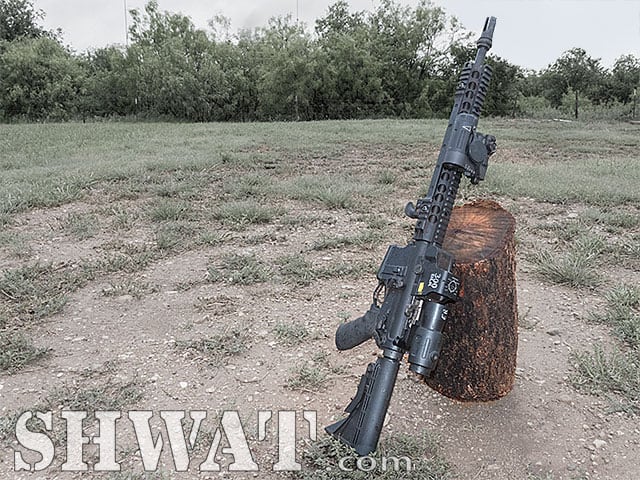
What Night Vision Should I Use?
I’ve lost track of how many times that’s come up over the years. If you’re looking for a canned answer, you’re in the wrong place. Given the plethora of options and new gear that keeps hitting the market, the answer can change quickly. I’ve successfully hunted varmints and hogs with a variety of night vision and thermal gear and I’ve liked most of what I’ve used. Some gear keeps coming back around and winning the day again and again. Such was the case on a recent wild hog hunt with friends and writers Brian McCombie and Katie Ainsworth Read this story and you’ll have an idea about how some of the available options play out.
This story started out as an opportunity to go hands-on with some Remington Defense rifles newly available to civilians. Arguably, though, there are more hogs out at night munching on Spike Box Ranch wheat than we see in daylight. So to make the hunt all it could be, I called up SHWAT™ sponsors TNVC, Tactical Night Vision Company. On staff they have several real deal tactical night vision gurus; bad for bad guys in the dark and bad for hogs and varmints, too!
On this hunt we equipped our Remington rifles with a variety of Night Vision gear; no thermal equipment was used. That brings up a common point of confusion when dealing with the question, “What night vision should I use?”
If you’re new to lights out high tech night hunting, you might refer to all the tools and toys under the heading “Night Vision.” I did when I first started. There are two fundamentally different kinds of optics used to let us see in the dark when hunting, “Night Vision” (often abbreviated “NV”) and “Thermal.” Essentially, NV amplifies existing light whereas thermal sees temperature. Both are amazing. Some people have strong preferences for one or the other. I like it all, for different reasons. On this hunt, each of us used different pieces of NV gear which suited the hunting style in West Texas nicely.
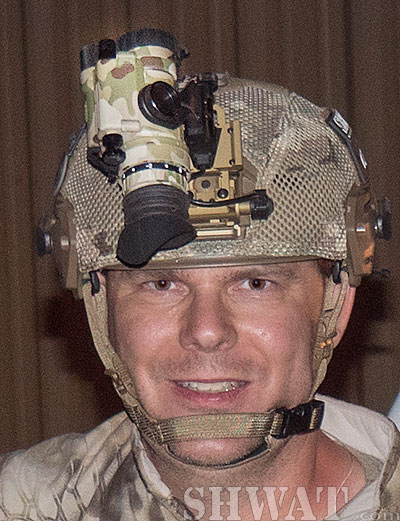 Helmet Mounted Monocular – The Head Game
Helmet Mounted Monocular – The Head Game
While you could sit in a blind at Spike Box, I don’t. I prefer riding in a full size four wheel drive truck around a pasture that hogs are known to frequent. When we spot hogs, we either stalk up close on foot or engage in what the Spike Box guides call “rodeo” – an armed vehicular assault on the wild hogs. I like that ride to be lights out and operated under NV, giving us maximum stealth. That’s one of the advantages of using the kit I did on this hunt: a helmet mounted NV monocular called a TNV/PVS-14 combined with DBAL (Dual Beam Aiming Laser) mounted to my Remington R4.
The TNV/PVS-14 monocular allows for pretty natural navigation, both in the vehicle and out. While driving the ranch roads with lights out, the helmet mounted unmagnified device allows you turn your head, scanning through the windshield, checking the driver’s side, the passenger side. Exit the vehicle and walk through the brush on the edge of the pasture or into the wheat and you can easily dodge the thorny mesquite tree that’s eager to snare you. One the one hand, it’s completely natural. On the other hand, not so much. With the monocular over my right eye I have great peripheral vision (albeit in the dark) with my left eye but none at all on my right side. In close proximity to others, avoiding bumping into my hunting partners can be a challenge. On the other hand, the ability to see in the dark lets me know where the others are.
A PVS-14 alone is great for navigation, but if you’re going to shoot a hog, varmint or other target you’re going to need more. It’s not something that works well with iron sights, though it could be detached and reattached to a rifle behind a NV compatible EOTech or Aimpoint sight. But then you give up the ability to look around that you have with the monocular helmet mounted.
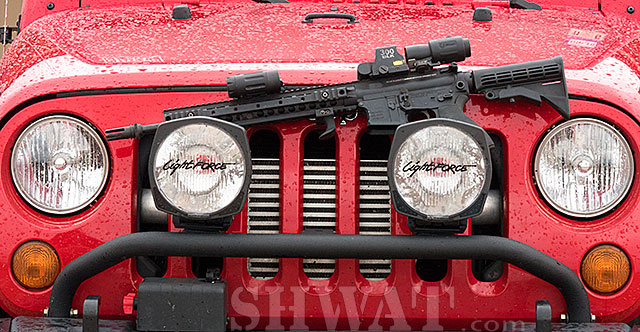
Like in the movies and military, I added a laser aiming device to my night hunting kit. On this hunt, I mounted to my Remington R4 AR-15 the eye safe Steiner DBAL-D2 Class 1 IR Laser from TNVC. This multifunction device proved quite valuable to me.
Designed to be mounted on your rifle, the DBAL-D2 has an IR (Infrared) laser pointer. You’ve seen this in the movies. The green dot allows the NV equipped shooter to aim at the enemy under the cover of darkness. The enemy, which might just be a wild hog destroying crops, can’t see the laser and has no idea it’s targeted. The D2 also has an IR illuminator, essentially a NV flashlight. While not always needed when enough ambient light from the moon or stars is available, the illuminator does for NV what your flashlight does for you. On the Steiner DBAL-D2, it can focus the IR light to a perfect disk a long ways away or provide a diffused broader light for up close hunting. Somewhere in between has been most useful to me.
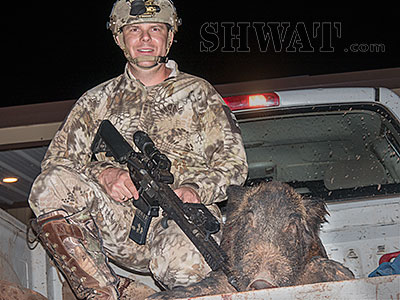 So here’s how this worked out for me. In one case, Ainsworth and I were out with Anthony, our Spike Box Guide. We were patrolling the perimeter of a large pasture when I spotted the first hog near the parallel fence line. By the time I was out of the truck, though, that pig had crossed the fence to safety! A quick turn of my head to the right and I spotted another one. Short version of the story, the hog went down in a hail of gunfire! And that has something to do with why I think hunting this way beats sitting in stands.
So here’s how this worked out for me. In one case, Ainsworth and I were out with Anthony, our Spike Box Guide. We were patrolling the perimeter of a large pasture when I spotted the first hog near the parallel fence line. By the time I was out of the truck, though, that pig had crossed the fence to safety! A quick turn of my head to the right and I spotted another one. Short version of the story, the hog went down in a hail of gunfire! And that has something to do with why I think hunting this way beats sitting in stands.
In the rodeo style hunt from the truck, I turned off the TNV/PVS-14 as we switched to white lights for the driver to blast through the field chasing the hogs. The DBAL-D2 also has a visible laser that conveniently zeros with the IR laser. I switched that red laser on and more pigs hit the dirt. That’s another thing I like about this set up: The DBAL-D2 is super versatile, working with both visible light and NV.
Rifle Mounted Night Vision Scopes – The Green and White
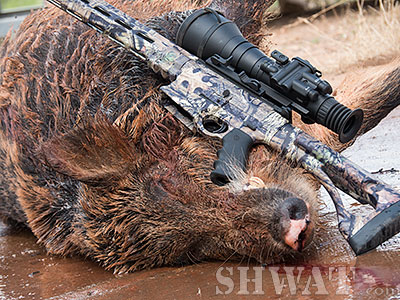 That said, while it might be the coolest kit for NV hunting, the helmet mounted PVS-14 isn’t necessarily the easiest thing to get started in night hunting. Fortunately, TNVC provided a Night Optics Gen 3 D750 Marauder 4x magnified NV scope and a Gen 2 White Phosphor D760. I didn’t have the chance to use either, but they sure looked sweet. I asked Brian McCombie to chime in here with his thoughts on using these two rifle mounted magnified scopes for hog hunting with his Remington R25 Gen 2 .308 rifle:
That said, while it might be the coolest kit for NV hunting, the helmet mounted PVS-14 isn’t necessarily the easiest thing to get started in night hunting. Fortunately, TNVC provided a Night Optics Gen 3 D750 Marauder 4x magnified NV scope and a Gen 2 White Phosphor D760. I didn’t have the chance to use either, but they sure looked sweet. I asked Brian McCombie to chime in here with his thoughts on using these two rifle mounted magnified scopes for hog hunting with his Remington R25 Gen 2 .308 rifle:
With a full or partial moon, I was able to see out to 500-plus yards in the dead of night, and see well enough to know if I was seeing cattle or hogs—at distance. Even on an overcast night, I could make out objects to several hundred yards, and then stalk up close enough for a better look.
The crosshairs are fairly sharp and visible, even when placed against a dark animal. The magnification on the two TNVC scopes I used was a big help, to both distinguish details of the target and to provide me with the general lay of the land when I was stalking across open ground. The latter is quite important, especially when hunting new land; the TNVC scopes helped me avoid things like hidden ditches and low-level fences that could easily lead to a busted leg or ankle. The fixed scope is a lot easier for me to get on target than the head and gun mounted gear Jonathan used.
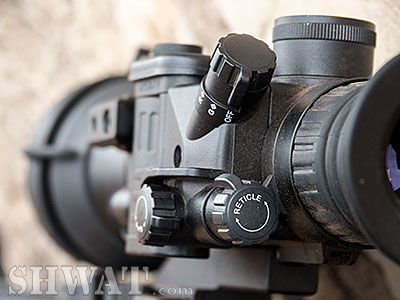 To me, the D750 Marauder really looked amazing. If you’re familiar with the D740, the D750 is similarly a 4x magnified optic but with 25-30% more light transmission. The image was detailed, clean, had great contrast and was bright. The physical controls are better laid out as well.
To me, the D750 Marauder really looked amazing. If you’re familiar with the D740, the D750 is similarly a 4x magnified optic but with 25-30% more light transmission. The image was detailed, clean, had great contrast and was bright. The physical controls are better laid out as well.
The White Phosphor Gladius D760 was a Gen 2 6x magnified optic. While Gen 2, the additional magnification is really hard to argue with. Instead of a green image, you get a brighter black and white image which some people who struggle with degrees of color blindness find superior.
So there you have some options. I really enjoy the combination of a PVS-14 and laser. Maybe I’ve watched too many movies, but then again for lights out CQHH (Close Quarters Hog Hunting) it has served me well. For nighttime navigation, it’s the best set up I’ve used. But you can’t really argue with the magnified optics as your range to target increases. What’s best for you? Well, you might need to strike up a conversation on our Tactical Hunting forum here to dig in deeper, but I hope this gives you a good start on your decision making.
TNVC Equipment Details from TNVC.com
TNV/PVS14 Currently, these start around $3200, but you can save roughly 10% on blemished units when they are in stock.
Steiner DBAL-D2 Class 1 IR Laser $1699 – $1754
D760 Gladius 6x Gen2 White Phosphor Night Vision Scope $2999
D750 Marauder 4x Gen3 Night Vision Scope $5,299.99 – $5,699.99



